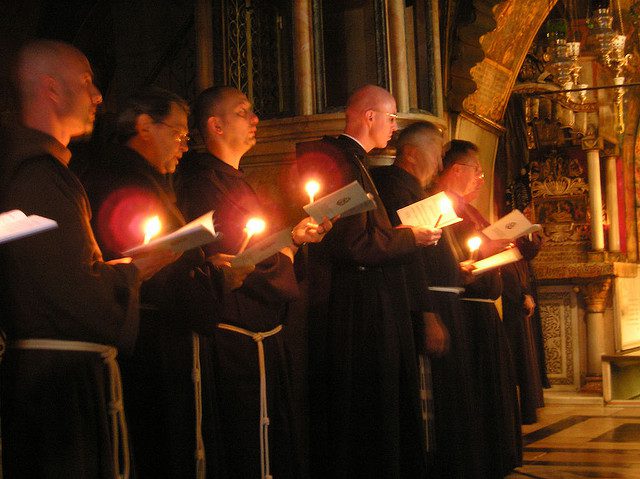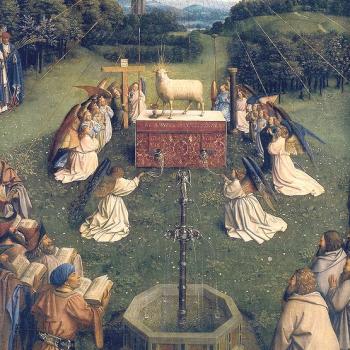
A Catholic parish is not a monastery. That is, it’s not an all-male environment (thus, the propriety of altar girls and not just altar boys).
***
An anonymous commenter opined underneath my post, Do Altar Girls Alter Intentions of Would-Be Altar Boys? This is my reply. My words from my previous post are in green, his words in blue, and my present responses in black.
***
Some thoughts, Mr. Armstrong:
If a boy feels led to be an altar server, he will do it whether there are girls or not. A call is far deeper than mere external, circumstantial elements.
This is odd and irrelevant, since the argument on offer is precisely that the presence of altar girls will lead a boy to be less interested in altar service. That is, indeed, the experience of huge numbers of Catholics in huge numbers of parishes.
I should have been more specific, but by “led” and “call” I meant the ones who were particularly serious about it in a way that eventual priests are. So what I meant was to tie this into a feeling of calling or possible calling to the priesthood (as I elaborated upon elsewhere in my paper). This is what I meant there, by “call.” The presence of girls would not and should not stop those boys. If so, I wold question the validity of their call.
At any rate, I’ve never once heard a boy describe anything like a “vocation” to altar service, it’s always just been something they do, often (initially) because their parents volunteered or suggested them and later (sometimes) because they develop a genuine interest and enjoyment of it. I don’t see why young boys should be alienated from the opportunity to develop such an interest/enjoyment later simply because it doesn’t exist initially. We can hardly expect 11-year-old boys to spontaneously initiate a fully-formed desire to do anything difficult and demanding, can we?
We can bow to the “girls are yucky” mentality or we can educate boys to not feel so uncomfortable about it. I was responding specifically to the argument that “altar boys lead to more priestly vocations, so less altar boys (because of altar girls) means less priestly vocations.”
The numbers of priests continue to increase, and that is simultaneous with a wide use of altar girls, so I don’t see that one thing is hindering the other.
The number of priests increases every time an ordination happens, but that’s not the relevant metric, is it?
One ordination is not the same as a net gain in numbers. It is relevant if the discussion is about what I described above: the relationship of being an altar boy to priestly vocations.
The number of diocesan priests in active ministry continues a long pattern of decline.
The number of diocesan priests in the world in 1970 was 270,924. In 2015 it was 281,514. The number has grown every five years since 1985, and that growth occurred alongside the widespread practice of altar girls.
And, at any rate, the argument is not that the number of priests is tied directly and exclusively to the presence/absence of altar girls and nothing else.
To hear many people talk, it is.
Doing away with altar girls will, in at least some places, help, but it will not be a panacea, and no serious person suggests otherwise.
Then I’ll let you tell the people who argue in this way that they ain’t serious. :-)
Another point I would make is that priests will need to learn how to interact with women and girls. It’s not an all-male culture (being in a monastery is that). A parish priest has to work with all sorts of people: half of whom (often more than half) are women. So it seems to me helpful that future priests start young and learn to interact with girls. It may be awkward (I know: I went through that) but not impossible.
Okay, but it doesn’t follow that a boy needs to interact with women everywhere he goes and in everything he does. We don’t expect them to socialize with women while showering after gym class, or while playing board games with his guy friends. There can be areas of social life marked off exclusively for boys, and indeed there ought to be, just as there can and ought to be areas of social life marked off exclusively for girls.
That’s right, but it’s a separate issue. The nature of the Mass and “going to church” is a mixed environment of males and females, like school is, except that there are also all ages.
Nor is being an altar boy required to be a priest or a good Catholic. None of my three boys ever had a desire to serve the altar, and we didn’t force them. You can’t create a deep-seated desire. It either is there or it isn’t.
Again, I’m not sure what a desire to serve at the altar has to do with anything, beyond actually getting them into the altar server corps, where the seeds of a vocation can be planted.
Presumably, it is preferable for a boy or girl to have the desire to serve the altar; not merely to be forced.
But here’s a question: does your parish use altar girls?
No; never. I attended a parish for 25 years that was a very traditional ordinary form Latin Mass. The one I go to now (which used to be connected to my older one as a parish cluster) has the Mass in English, but is still liturgically traditional (altar rails, and no altar girls). But I have no intrinsic opposition to altar girls, just as I never had any essential opposition to Holy Communion in the hand: which 95% of recipients in our former parish did not do. And that’s because I’m not legalistic, and I know my church history (as to Holy Communion).
If so, what in the world convinces you that your boys are not interested in it for just that reason?
It obviously wasn’t a reason, since there were no girls. I’m not saying it’s the only reason for boys’ reluctance. That is the argument made: that it is the main or sole reason for a decline of boys’ participation. If that’s true, I say we rectify it by moving forward and through education; not by forbidding altar girls. My three boys are all rock-solid Catholics, and active in outreach, education, evangelism, and youth groups activities. Their not being altar boys was obviously not through a lack of desire to serve in a general sense. They simply didn’t want to do it. There are lots of things to be done in the Church.
If my sons had wanted to be altar boys and said, “I don’t wanna do it because there are yucky girls up there,” they would have been soundly and roundly rebuked. That would have been a moment to teach them proper priorities (serving God in a way that one feels called to as more important than being socially awkward about girls).
“Girls are yucky” is an extremely reductive attitude toward the argument of the opposite side, and not very helpful at all.
They make a valid point about the social development of boys. This is an issue, whatever we may think of it. I think the solution (as far as church goes) is social and educational, not legalistic.
The simple fact is that at some point, young boys are going to start wanting to develop a properly masculine identity, to pull away from the feminine sphere of social life in which they had, up to that point, been nurtured and formed, and to root themselves in something else. It is perfectly normal, at a certain age, indeed perhaps even a real psychological need, for young boys to develop a healthy interest in characteristically masculine activities that can be done with other boys, and to lose interest in things that are not characteristically masculine.
Exactly. We don’t disagree at all about that. I was a boy once, and raised three boys, and I know how these things work. I majored in sociology, too: the study of human group behavior.
If they truly want to serve and feel called to that and possibly to the priesthood, the mere fact that girls are altar servers should not be any sort of hindrance. In the seriousness of their thinking, the boys who feel called will already be well beyond that.
Again, we simply cannot expect 11-year-olds to spontaneously develop a fully-formed vocation in their hearts. With few, rare exceptions, most boys who will eventually enter the priesthood will have at best a weak attachment to the idea at such an age.
That’s why I used the word “possibly.”
That doesn’t mean they can’t be helped to develop a stronger vocation, or that they ought to be prematurely alienated from it because it’s weak.
I agree. I don’t think altar girls is a “knockout punch” against any of that.
I think it trivializes the very notion of a true calling or vocation, to argue that it would be overcome by a mere altar girl, as if girls are some kind of alien or something.
I think you are indulging in an oddly gnostic sense of vocation as something communicated from on high in the privacy of one’s heart, exclusively accessible only to that one, without being in any way formed by one’s environment.
I never said any such thing. Of course it occurs in an environment. That’s why Buddhist or Muslim kids don’t feel a vocation to the Catholic priesthood.
A vocation to the priesthood is always an invitation to enter more deeply into the life of the Church and to participate more profoundly in the ministry of Christ. If the invitation is made in an unappealing way, we simply cannot expect people to accept it. Deliberately making it unappealing in order to alienate all but the exceptional rare few blessed with unusually strong senses of vocation from a very early age seems far more problematic to me.
In the end, it is still an interior calling: fostered by environment, yes, but it is internal, and will be felt if a person is open to it. They feel the call or vocation and then consult spiritual superiors to confirm or disconfirm it. See, along these lines, an excellent article, “Six Steps in Vocation Discernment” (Diocese of Harrisburg).
Being a parish priest is not a “manly environment”. It’s a mixed environment. Being a monk is a manly environment.
‘Being a parish priest’ is not an ‘environment’ at all, it is a vocation, a way of life. And it is absolutely a manly vocation and a manly way of life, hence why only men can be priests.
I phrased that wrongly. A better way to say it would be: “The environment in which a parish priest serves is not men-only, but both genders.” My point was not at all that being a priest is not “manly.” And I think that could have been figured out, in context.
If vocations had been decreasing, perhaps some of the arguments against altar girls as hindrances to priestly vocations might have some weight, but as it is, even American vocations are increasing, with the presence of large numbers of altar girls.
This does not mean much if they are coming disproportionately from places where altar girls are not used. We have some limited, anecdotal evidence, at least, that that’s the case. Vocations, after all, develop locally, not system-wide.
They also come from parishes where altar girls are used. Christ the King parish in Ann Arbor, Michigan (I personally know Fr. Ed Fride) has had 15-20 vocations to the priesthood in 25 years (up to the year 2007); also six women from the parish in five years had joined religious life. It’s a charismatic parish, and Fr. Fride attributes the vocations to perpetual eucharistic adoration, and preaching “orthodoxy, the Eucharist and the centrality of Jesus.” They use altar girls at this parish (as do most others these days).
God is either calling a person to be a priest or not. Whether He is (from God’s perspective) has absolutely no relation to extraneous factors such as altar girls, opposition in the family, etc.
This is, again, that odd gnostic view of vocations that I find so alarming. We simply do not get to take steps to alienate boys from considering the priesthood and then blame them for not entering the priesthood. If you want people to accept an invitation, make it appealing.
I deny that a young girl up on the altar piously serving will dissuade any real vocation to the priesthood. It’s irrelevant to that. It apparently (in fact) dissuades a good number of boys from being altar servers (those not called to the priesthood). If so, the answer is education, not resort to legalism. The Church has allowed altar girls. Some traditional parishes like the ones I have attended have only boys, which is the tradition. That’s okay, too. Again, parish priesthood involves dealing with women and girls. It’s not an all-male environment. So it’s good and healthy and wise to start early in getting future priests to be used to interacting with the opposite sex.
If one thinks altar girls are essentially wrong and forbidden, then the problem there is with a saint and pope (Pope John Paul II) allowing it (and Pope Benedict XVI and Pope Francis not forbidding it). The problem is with Church authority; then one has to work through that.
It is not, at all, an issue with “Church authority” to suggest that allowing altar girls is imprudent and unwise, since the Church herself does not require it;
Nor does it forbid it, which it would do if it were such a terrible thing.
and if it is disobedient to think the policy is wrong now, then it was equally disobedient to think it wrong before, when girls were excluded.
It is indeed a discipline matter, which can change.
Obviously, people were allowed to think it wrong before, which is why the policy was changed. There is no reason it cannot change again.
That’s right. So we make our arguments back and forth, and this is one way that beliefs and practice develop in the Church. You have not given me sufficient reason to overthrow my present opinion on the issue. But it was good dialogue, and I thank you for that.
***
Photo credit: Catholic monks during the procession in the Holy Sepulchre in Jerusalem, Old City (photo taken by Abraham Sobkowski OFM: 2006) [Wikimedia Commons / Creative Commons Attribution-Share Alike 3.0 Unported license]
***












